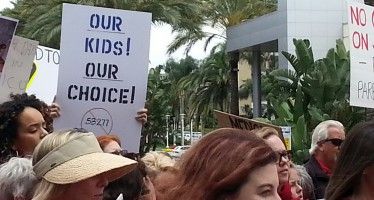Feds To Erode CA's Green-Power Edge
NOV. 8, 2010
By WAYNE LUSVARDI
California’s often-myopic embrace of “green power” may soon come back to hurt the state. The Obama-administration-controlled Federal Energy Regulatory Commission (FERC) is considering a new rule that may stifle any economic recovery in California and make implementation of the state’s green power law even more uneconomic by having to pay for other nearby state’s green power lines without any green jobs or environmental pay back to Californians.
The Wall Street Journal is reporting that FERC is proposing a new rule that would socialize (i.e., nationalize) the costs of new electric transmission lines for green power – read “The Great Transmission Heist” here:
Socialized green power would result in California further running in the red not only by an out flow of revenues to other states to subsidize their green power rates but also by outsourcing green jobs to other states. With California’s green power law, California was hoping to lessen its dependence on imported power from Utah, Arizona and Utah and natural gas from Texas in order to rebalance its deficit-plagued state budget. But with socialization of the transmission grid any gains in revenue or taxes might be offset by outward subsidies to other states.
FERC is proposing to make a ruling to socialize the costs of new transmission lines in lieu of a bill that died in the U.S. Senate proposed by Sens. Harry Reid of Nevada and Jeff Bingaman of New Mexico. The Obama Administration and Democratic Party leaders have decided to push FERC to render a ruling that would in effect do what the dead legislation proposed. Reid’s bill, the Clean Renewable Energy and Economic Development Act, S.539, would have allowed FERC to step in if states couldn’t agree on cost allocation and cost shifting to build-out a green transmission grid in designated renewable energy zones.
The governors of California, Michigan, Arizona, Oregon and Washington reportedly opposed the original Senate bill on the grounds that it would “cost shift” green power transmission costs onto their states.
The financing of transmission lines has traditionally been done by local end-users through higher electricity rates to pay the amortized costs of the lines. The prevailing rule has been that the “beneficiary pays.”
The anticipated shift in control of the U.S. House of Representatives to Republicans probably had something to do with the White House and Democrats trying to end-run Congress and push for a ruling from FERC. Both the White House and Democrats in Congress are desperate for job creation and believe that green power is a primrose path to economic recovery no matter what the costs or foreseeable negative consequences.
As the Wall Street Journal aptly points out, socializing green power transmission wouldn’t be considered if it were economically viable in the first place.
However, the actual wording of the proposed regulation (FERC RM10-23) states: “(1) The costs of a new interregional facility must be allocated to each transmission planning region in which that facility is located in a manner that is at least roughly commensurate with the estimated benefits of that facility in each of the transmission planning regions;” and “ (2) A transmission planning region that receives no benefit from an interregional transmission facility that is located in that region, either at present or in a likely future scenario, must not be involuntarily allocated any of the costs of that facility.”
This seems to be an admission that wind power in particular can’t work except on a regional level. If wind isn’t blowing in California when there is a heat wave or cold snap then maybe electricity can be imported from a wind farm in, say, Nevada and transmitted to Los Angeles via a new green line and vice versa. California could sell its green power to other nearby states but California is the biggest market in the western region.
The proposed FERC rule is said to force “incumbent utilities” to forego their “first right of refusal” to build transmission lines within its service area. So electricity ratepayers within each state would have no say in whether they wanted to pay for such facilities. Even if the grid were only regionally socialized, home rule would be usurped by regional rule. Californians would end up paying for transmission facilities in nearby western states and vice versa. This would undercut California’s plans for green power to bail out the state from its budget deficits partly caused by dependence on imported power.
Ironically, it may have been actions by California’s new “Green” Gov.-elect – Jerry Brown – that provoked the White House and other Democrats to push FERC to socialize the costs of new electric transmission lines.
In June 2010, Brown, in his current role as California attorney general, petitioned FERC to ratify California’s Assembly Bill 1613 that would allow Feed-In Tariffs for green power. Feed-In Tariffs are premiums added to electricity rates to pay for the over-market cost of green power. But in July FERC denied Brown’s petition on the grounds that it would allow California to control both the wholesale and retail ends of electricity prices, which would be conducive to gaming the system by arbitraging.
FERC made it explicit that it didn’t want to put the added costs of green power onto the backs of electricity ratepayers but instead preferred tax credits, loans, loan guarantees, and other mechanisms to subsidize green power. In other words, FERC didn’t want overt subsidies for green power that ratepayers would feel immediately in their electricity bills.
Ironically, California voters just shot down a voter initiative, Prop. 23, that would have delayed the roll out of green power in California until unemployment dropped from 12 percent to 5.5 percent. The apparent message sent by voters is that they want the green jobs promised under California’s green power Law. And they just might get them – only in other states.
Related Articles
County payroll hikes stay ahead of population increases
Sierra County, tucked in the foothills once traversed by the Donner Party along the Nevada border, has seen its population
Governor adopts budget realism
MAY 14, 2010 By JOHN SEILER The party’s over. That’s the message from Gov. Arnold Schwarzenegger’s austere May Revise, released
CA Democratic Convention: Marginalized group challenges party to stand for “health choice”
At this weekend’s state party convention, California Democrats went out of their way to acknowledge marginalized groups and affirm their




